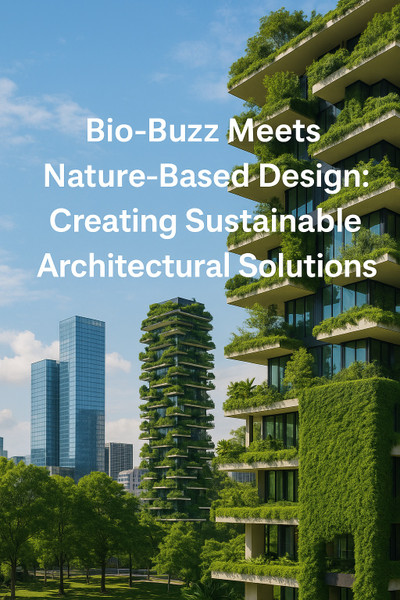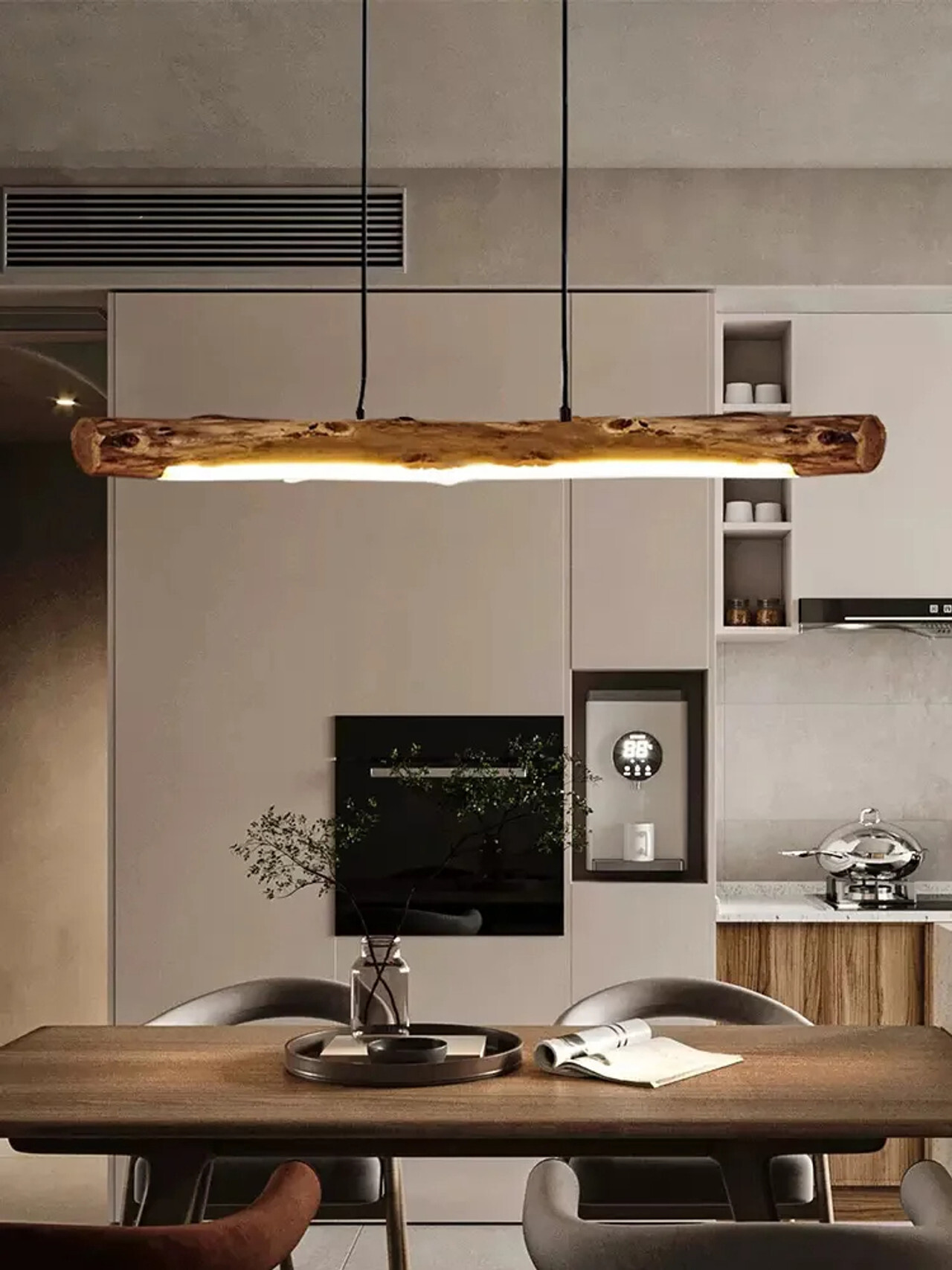Bio-Buzz Meets Nature-Based Design: Creating Sustainable Architectural Solutions
Posted by Elodie Allington - Architect on May 14, 2025
Bio-Buzz Meets Nature-Based Design: Creating Sustainable Architectural Solutions
In the contemporary era, architecture is increasingly moving towards sustainable and regenerative practices. The integration of bio-buzz – a concept that encompasses biomimicry, biophilia, and bio-architecture – with nature-based design is emerging as a powerful paradigm for creating structures that are not only aesthetically pleasing but also ecologically responsible. This article explores how the convergence of these principles is shaping the future of architecture, the benefits of such approaches, notable case studies that exemplify their application, and the challenges and future outlook of these transformative practices.
The Rise of Bio-Buzz in Architecture
Bio-buzz refers to the growing interest in leveraging natural systems and processes to inform design and construction. It involves understanding and emulating the patterns and strategies found in nature to solve human challenges. Biomimicry, biophilia, and bio-architecture are key components of this movement.
-
Biomimicry: Biomimicry involves studying the forms, processes, and ecosystems in nature to inspire architectural solutions. It is about mimicking the efficiency and resilience found in nature, such as the way termite mounds maintain internal temperatures or how lotus leaves repel water and dirt. The concept has been applied to skyscrapers, bridges, and urban planning, optimizing structural integrity while reducing energy consumption.
-
Biophilia: Biophilia refers to the innate human connection with nature. Integrating natural elements like plants, water, and natural light into architectural design not only enhances aesthetic appeal but also promotes psychological well-being and productivity. Studies have shown that biophilic design can significantly reduce stress, improve cognitive function, and foster creativity in workplaces and residential areas.
-
Bio-Architecture: Bio-architecture takes these concepts a step further by incorporating organic forms and living systems into building structures. This includes green roofs, living walls, and bio-based materials that actively engage with their surroundings. Bio-architecture fosters symbiosis between the built environment and the natural world, effectively turning buildings into living organisms.
Nature-Based Design: A Holistic Approach
Nature-based design emphasizes using nature as a model, measure, and mentor in architectural development. It involves the application of ecological principles, such as closed-loop systems, energy efficiency, and biodiversity promotion. By considering a building’s lifecycle, from material sourcing to end-of-life disposal, architects can minimize environmental impact.
-
Ecological Integration: Designing with ecosystems in mind ensures that structures work in harmony with local flora and fauna. This includes preserving existing habitats and creating new green spaces that promote biodiversity. Projects like the "Urban Jungle" in Singapore demonstrate how vertical gardens can integrate seamlessly into urban landscapes, attracting pollinators and creating microclimates.
-
Energy Efficiency: Nature-based design often incorporates passive heating and cooling systems, natural ventilation, and renewable energy solutions that reduce reliance on non-renewable resources. Examples include passive solar design, wind towers, and geothermal systems.
-
Circular Economy Principles: Incorporating recycled and sustainable materials, along with designing for disassembly and reuse, is crucial to minimizing waste. Pioneering projects like the "Circular House" in the Netherlands have showcased how modular design and sustainable sourcing can drastically reduce construction waste.
Expanded Case Studies: Exemplifying the Synergy
-
The Eastgate Centre, Harare, Zimbabwe: This building mimics the self-cooling properties of termite mounds, resulting in a passive cooling system that uses 90% less energy than conventional buildings of its size. By analyzing how termites regulate airflow and temperature within their mounds, architects developed a structure that requires minimal mechanical cooling and heating systems.
-
The Eden Project, Cornwall, UK: Featuring massive biomes constructed from ETFE panels, the Eden Project demonstrates how lightweight, translucent materials can create controlled environments that mimic natural ecosystems. Each biome houses different climatic conditions, fostering educational and research opportunities focused on plant species conservation.
-
Bosco Verticale, Milan, Italy: A striking example of bio-architecture, Bosco Verticale incorporates over 800 trees and 15,000 plants, forming a vertical forest that reduces urban heat, improves air quality, and enhances biodiversity. The project not only absorbs CO2 and dust particles but also provides habitats for birds and insects in an urban setting.
-
One Central Park, Sydney, Australia: Integrating a 100-meter vertical garden, this residential tower showcases how nature-based design can transform high-density living. The building uses recycled water systems, solar energy, and plant-covered facades to reduce its environmental footprint.
-
Living Building Challenge, International: A rigorous green building certification program, the Living Building Challenge encourages architects to go beyond conventional sustainability practices by designing buildings that are net-positive in energy, water, and waste. Notable examples include the Bullitt Center in Seattle, which generates its own energy through solar panels and collects rainwater for reuse.
-
Mushroom Tower, New York City, USA: Constructed using mycelium, the Mushroom Tower is a biodegradable structure that demonstrates the potential of bio-based materials in architecture. The structure is grown rather than built, showcasing how nature-based solutions can drastically reduce the carbon footprint of construction.
Challenges and Future Directions
Despite its promise, the integration of bio-buzz and nature-based design faces several formidable challenges. While the benefits of these approaches are well-documented, their widespread adoption remains constrained by economic, technological, cultural, and regulatory factors. Overcoming these barriers requires a concerted effort from architects, policymakers, developers, and the public to reimagine how we approach sustainable construction and urban planning.
Cost Implications: The financial aspect is perhaps the most immediate challenge. Many sustainable materials and systems necessitate higher upfront investments, which can be a deterrent for developers focused on short-term financial returns. For instance, bio-based materials like mycelium bricks or algae facades are not yet mass-produced at a scale that lowers costs to parity with conventional materials like concrete or steel. Additionally, integrating complex systems such as solar panels, rainwater harvesting, and green walls can significantly increase construction costs. However, it is essential to consider the long-term financial gains associated with reduced energy consumption, lower maintenance costs, and potential tax incentives for sustainable buildings. Furthermore, the cost of inaction – in the form of rising energy prices, increased regulatory fees, and reputational damage – may ultimately outweigh initial expenditures.
Technological Integration: Implementing nature-based systems like living walls, vertical forests, and bio-reactive facades requires specialized knowledge and ongoing maintenance. The technology to monitor and sustain these systems is still in its nascent stages, particularly in regions lacking expertise in green architecture. Additionally, integrating smart systems that respond dynamically to environmental conditions – such as solar-tracking windows or energy-generating algae panels – can present technical challenges that demand further research and development. The complexity of managing these systems also raises concerns about operational efficiency, as even minor malfunctions can compromise the entire building’s performance, requiring specialized personnel for maintenance and repairs.
Supply Chain and Material Availability: Sustainable construction often relies on specific materials that may not be readily accessible or economically viable in all regions. For example, bamboo is a rapidly renewable resource but may need to be imported to areas where it is not locally grown, increasing transportation costs and carbon footprint. Similarly, bio-based materials like hempcrete, recycled plastics, and mycelium are not yet as widely available as conventional construction materials, limiting their scalability. The supply chain for these materials is also susceptible to disruptions, which can exacerbate project delays and cost overruns. Additionally, fluctuations in market demand for green materials can result in price volatility, making budget planning more complex for developers.
Cultural and Regulatory Barriers: Traditional construction practices and zoning laws can restrict the adoption of unconventional architectural designs. In many regions, building codes do not account for bio-based materials, living walls, or regenerative systems, creating additional regulatory hurdles. Moreover, public perception can also pose a barrier – stakeholders accustomed to conventional designs may be hesitant to embrace nature-based solutions, perceiving them as experimental or less durable. Education and advocacy are crucial to reshaping public perception and fostering greater acceptance of green architecture. Moreover, the lack of standardized guidelines for bio-architecture complicates the approval process, increasing the likelihood of project delays or rejections.
Education and Training: The integration of bio-buzz and nature-based design requires a new generation of architects and builders equipped with specialized training in sustainable construction techniques. Educational institutions must update their curricula to include biomimicry, regenerative design, and sustainable urban planning. Additionally, ongoing professional development is essential to keep architects and engineers informed about emerging technologies and best practices in sustainable architecture. The lack of qualified personnel to implement and maintain these systems can result in suboptimal performance and higher maintenance costs. Furthermore, training existing construction workers and technicians to work with new materials and systems presents logistical and financial challenges that must be addressed to ensure successful implementation.
Data and Performance Monitoring: A critical yet often overlooked aspect of nature-based design is the need for comprehensive data monitoring to assess the effectiveness of bio-based systems. Implementing sensors and analytics to track the performance of living walls, solar facades, and rainwater harvesting systems can provide valuable insights into their efficiency and potential areas for improvement. However, the integration of such systems adds another layer of complexity to construction projects, requiring expertise in data analytics and system integration. Moreover, ensuring data privacy and cybersecurity becomes paramount as buildings increasingly rely on interconnected smart systems to function effectively.
Despite its promise, the integration of bio-buzz and nature-based design faces several formidable challenges. While the benefits of these approaches are well-documented, their widespread adoption remains constrained by economic, technological, cultural, and regulatory factors. Overcoming these barriers requires a concerted effort from architects, policymakers, developers, and the public to reimagine how we approach sustainable construction and urban planning.
Cost Implications: The financial aspect is perhaps the most immediate challenge. Many sustainable materials and systems necessitate higher upfront investments, which can be a deterrent for developers focused on short-term financial returns. For instance, bio-based materials like mycelium bricks or algae facades are not yet mass-produced at a scale that lowers costs to parity with conventional materials like concrete or steel. Additionally, integrating complex systems such as solar panels, rainwater harvesting, and green walls can significantly increase construction costs. However, it is essential to consider the long-term financial gains associated with reduced energy consumption, lower maintenance costs, and potential tax incentives for sustainable buildings.
Technological Integration: Implementing nature-based systems like living walls, vertical forests, and bio-reactive facades requires specialized knowledge and ongoing maintenance. The technology to monitor and sustain these systems is still in its nascent stages, particularly in regions lacking expertise in green architecture. Additionally, integrating smart systems that respond dynamically to environmental conditions – such as solar-tracking windows or energy-generating algae panels – can present technical challenges that demand further research and development.
Supply Chain and Material Availability: Sustainable construction often relies on specific materials that may not be readily accessible or economically viable in all regions. For example, bamboo is a rapidly renewable resource but may need to be imported to areas where it is not locally grown, increasing transportation costs and carbon footprint. Similarly, bio-based materials like hempcrete, recycled plastics, and mycelium are not yet as widely available as conventional construction materials, limiting their scalability.
Cultural and Regulatory Barriers: Traditional construction practices and zoning laws can restrict the adoption of unconventional architectural designs. In many regions, building codes do not account for bio-based materials, living walls, or regenerative systems, creating additional regulatory hurdles. Moreover, public perception can also pose a barrier – stakeholders accustomed to conventional designs may be hesitant to embrace nature-based solutions, perceiving them as experimental or less durable.
Education and Training: The integration of bio-buzz and nature-based design requires a new generation of architects and builders equipped with specialized training in sustainable construction techniques. Educational institutions must update their curricula to include biomimicry, regenerative design, and sustainable urban planning. Additionally, ongoing professional development is essential to keep architects and engineers informed about emerging technologies and best practices in sustainable architecture.
Future Directions and Opportunities: Despite these challenges, the future of bio-buzz and nature-based design is promising. Advances in artificial intelligence, data analytics, and materials science are paving the way for more efficient and cost-effective sustainable solutions. Additionally, as governments worldwide implement stricter environmental regulations, the demand for green architecture is likely to increase. By focusing on modular design, prefabrication, and regenerative systems, architects can mitigate costs and expand the reach of nature-based solutions, setting a new standard for sustainable urban development.
Despite its promise, the integration of bio-buzz and nature-based design faces several challenges. High initial costs, maintenance complexity, and regulatory barriers can hinder widespread adoption. However, advancements in green technology, government incentives, and growing environmental awareness are paving the way for more widespread implementation.
-
Cost Implications: Many sustainable materials and systems require higher upfront investments, which can be a deterrent for developers focused on short-term returns.
-
Technological Integration: The implementation of complex bio-based systems, such as living walls and vertical forests, requires ongoing maintenance and expertise that may not be readily available in all regions.
-
Cultural and Regulatory Barriers: Traditional construction practices and zoning laws can restrict the adoption of unconventional architectural designs, making policy support crucial for advancing sustainable architecture.
Expanding the Scope: Future Possibilities
Looking forward, the potential of bio-buzz and nature-based design is vast. Integrating AI and advanced data analytics can optimize building performance by predicting environmental impacts and energy consumption patterns. Furthermore, the use of smart materials – such as self-healing concrete and algae-powered facades – could revolutionize how buildings interact with their environment.
Additionally, the concept of regenerative design, which aims to restore and renew natural systems rather than simply minimize harm, is gaining traction. This approach involves creating buildings that contribute positively to their surroundings, such as structures that clean air, generate energy, and support biodiversity.
Conclusion
As cities expand and environmental concerns intensify, the convergence of bio-buzz and nature-based design offers a compelling blueprint for sustainable architectural solutions. By drawing inspiration from nature’s time-tested strategies, architects can create structures that are not only functional and beautiful but also inextricably linked to the natural world. In doing so, they are not just building structures – they are fostering a new paradigm where human development and ecological preservation go hand in hand. The future of architecture lies in embracing the lessons of nature, not as a mere aesthetic choice but as a fundamental design ethos that can transform how we live, work, and coexist with the environment.
10 FAQs for Challenges and Future Directions in Bio-Buzz and Nature-Based Design
-
Why are the initial costs of bio-based systems and materials higher than conventional construction?
Bio-based systems often involve advanced technologies, specialized materials, and complex integration processes, all of which contribute to higher upfront costs. Additionally, many of these materials are not yet produced at scale, driving up prices. -
How can developers mitigate the cost implications associated with nature-based design?
Developers can mitigate costs by prioritizing modular design, sourcing locally available sustainable materials, and taking advantage of government incentives for green construction. Additionally, calculating long-term savings in energy and maintenance can justify the initial investment. -
What are the primary technological challenges in implementing living walls and vertical forests?
The primary challenges include maintaining optimal irrigation systems, managing plant health, ensuring structural integrity, and integrating smart systems to monitor performance without significantly increasing maintenance costs. -
How does the availability of sustainable materials impact project feasibility?
Limited availability of sustainable materials can lead to project delays, increased transportation costs, and potential design alterations. Developing localized supply chains and investing in research to scale production can alleviate these issues. -
What regulatory barriers exist for nature-based architecture?
Many building codes and zoning laws do not account for unconventional systems like green roofs or algae facades, resulting in lengthy approval processes. Updating regulations to include guidelines for bio-based systems can facilitate adoption. -
Why is public perception a challenge for nature-based design?
Public perception can be a barrier when stakeholders view nature-based systems as experimental, fragile, or less durable. Effective communication of long-term benefits and successful case studies can help shift this perception. -
How can educational institutions support the adoption of bio-buzz architecture?
By integrating courses on biomimicry, regenerative design, and sustainable construction, educational institutions can equip architects and engineers with the necessary skills to implement nature-based systems effectively. -
What training is required for construction personnel to work with bio-based systems?
Training includes learning how to handle new materials, install complex systems, maintain living walls, and utilize data monitoring tools to ensure optimal performance and sustainability. -
What role does data monitoring play in nature-based architecture?
Data monitoring is crucial for assessing the efficiency of systems like rainwater harvesting, solar facades, and green walls. It helps identify performance issues early and provides insights for optimizing design in future projects. -
How do cultural attitudes impact the adoption of bio-buzz and nature-based design?
Cultural resistance to unconventional designs can slow adoption. Public education campaigns and showcasing successful, aesthetically pleasing examples can help normalize these sustainable approaches in mainstream architecture.
Hi! We’re the Jas Writing Team — if you enjoyed this article, why not buy our writer a coffee? Every tip goes straight to the person behind the words — and yes, we really do spend it at our local coffee shop. Your support keeps the ideas (and lattes) flowing. Thank you!





